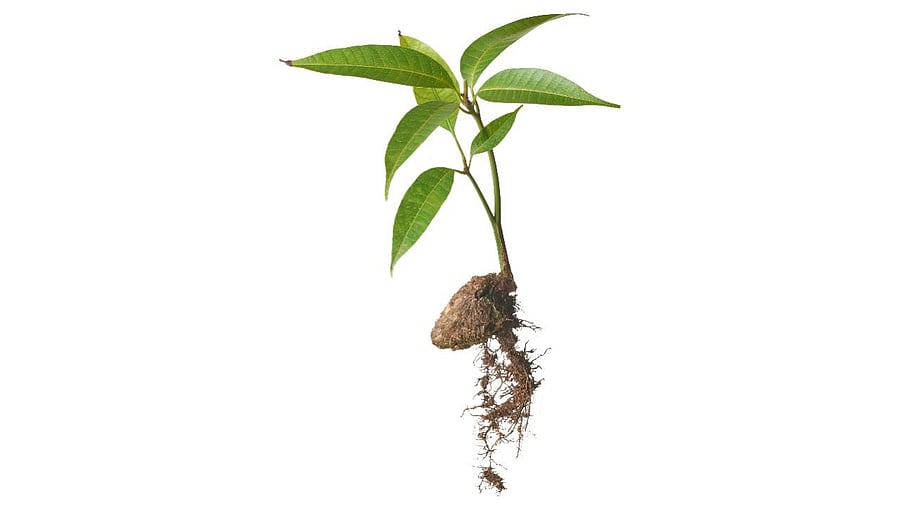
A sapling sprouts from a mango seed.
Mango season is the perfect time to grow your own mango tree. Instead of discarding the seed of the mango you enjoyed, drop it into a container and watch it sprout! And here’s why this timing works: the monsoon air, high humidity and almost daily showers give the seed all the moisture it needs.
These natural sprouts are so reliable that every year we give away many of them to friends and families. Some grow as ground trees in farms; others thrive in containers, typically large plastic containers. Container cultivation differs significantly from ground planting. While ground-grown trees develop extensive root systems and can access natural resources, container trees depend entirely on us for water and nutrition. And here’s how to address these concerns.
Start with a blue water drum or any container of about 200 litres. A mango tree has a tap-root, so depth matters more than width. Drill several holes through the base for good drainage and set it on bricks or a stand so excess water can run off freely. For soil preparation, mix red soil and well-aged manure in a 3:1 ratio by volume. Line the bottom with heavy pebbles, add a two-inch sand layer, top with half a foot of the soil mix, add another sand layer, then fill the rest with the soil mix. These sand layers encourage drainage and give room for the lateral roots branching from the taproot to spread.
Place the container where it will receive maximum sun on your terrace, balcony or out in the garden. Extract the seed, lay it 2-3 inches deep, cover it lightly with soil, and water the container. Within a fortnight, copper-coloured mango leaves should emerge.
If nothing appears after three weeks, keep the soil moist, check that the spot is warm enough or try a fresh seed. Expect the sapling to reach two to three feet in its first year and to bear its first fruit in six to eight years. Plastic containers retain moisture, so water sparingly. Instead of following a rigid schedule, watch the soil: water only when the top few centimetres feel dry. As the tree grows, its needs will also change.
Weather patterns matter too. Mango trees respond sharply to rainfall and temperature shifts, so yields fluctuate from season to season. Cold wintry nights followed by warm mornings trigger flowering. Early pre-monsoon showers that strike during bloom can wash away pollen and knock off young panicles, reducing fruit set. The same pre-monsoon rains arriving a few weeks later, when the fruit is filling, are known as mango showers. They cool the air and give developing mangoes the moisture they need to plump and sweeten.
Fertilisation needs are different for young and mature trees. For young trees in the preflowering phase, add farm manure twice a year, in spring and post-monsoon.
Once the tree starts yielding fruits, switch to phosphorus and potassium-rich fertilisers during the flowering and fruiting phases. After fruiting is complete, the tree enters a dormant phase. It is the ideal time to prune branches to keep the tree airy and prevent moisture from accumulating. This prevents infections. The seasonal cycle then restarts; fresh leaves and flowers start appearing in late December or early January through February, though this timing varies from tree to tree and the region where it’s grown.
If you want faster results and guaranteed fruit quality, consider grafted dwarf varieties. These bear fruit within 3-4 years compared to 6-8 years for seed-grown trees.
Whichever you choose, the wait is worth it. And if you do start a mango plant, email me a photograph.
Motley Garden is your monthly kaleidoscopic view into a sustainable garden ecosystem. The author believes gardens are shared spaces where plants and creatures thrive together.
READER QUERY
How do I improve the appearance of my balcony garden?
Balasubramaniam
Identical pots give symmetry but can look monotonous. Do not buy a dozen of the same size and arrange them in a straight line. Combine plants and containers of different sizes, shapes and colours. Tall palms or heliconias in high pots lend a tropical feel, medium bushy plants like philodendrons and Aglaonema add volume and small trailing plants like Portulaca soften corners. Variegated foliage and ferns provide extra
texture. Hang a few baskets and use multi-tiered stands for cacti and succulents; the layered heights create depth and a lush look. Finally, consider adding a small water bowl or a compact coffee table for an inviting focal point.
Write in with your garden queries and stories at allthingsinmygarden@gmail.com